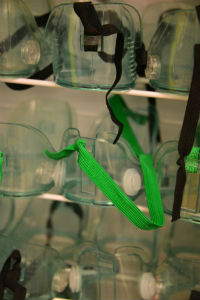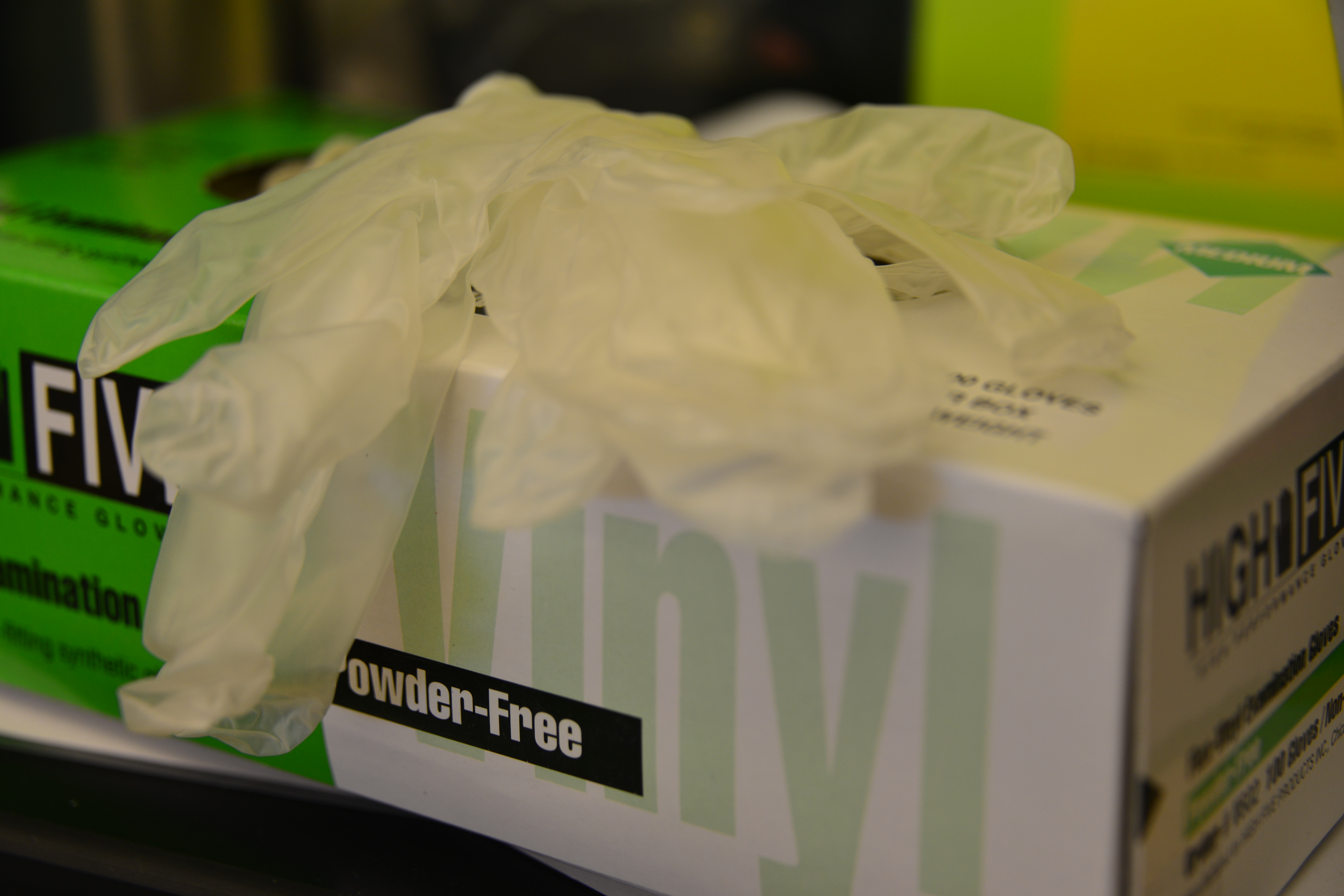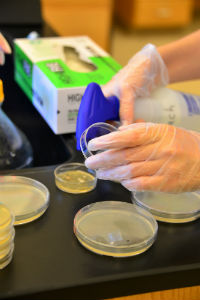Team:Montgomery Cougars NJUSA/Safety
From 2014hs.igem.org
(→Safety) |
(→Disposal) |
||
| (66 intermediate revisions not shown) | |||
| Line 4: | Line 4: | ||
__NOTOC__ | __NOTOC__ | ||
| - | + | ==iGEM Safety Questions== | |
| - | + | ===1. Would any of your project ideas raise safety issues?=== | |
| - | + | [[Image:gi.jpg|375px|right|thumb|The use of goggles in a lab environment is mandatory in our school.]] | |
| - | + | ||
| - | + | ||
| - | + | ||
| - | + | ||
| - | + | ||
| + | Montgomery High School's iGEM team works out of a high school laboratory with Containment Level 1. We use non-pathogenic strains of ''E. coli'' and do not work with any hazardous chemicals. Nevertheless, we ensure that all students tie up any long hair and wear gloves, safety goggles, pants, and closed-toed shoes during lab activities. All students underwent a lab safety demonstration in early January and practiced streaking bacteria, pipetting, etc. to ensure the use of proper technique. In regard to our lab environment, the classroom we use has multiple showers, a fire extinguisher, an eye-wash station, multiple sinks, and a first aid kit. | ||
| - | + | Our project is contained from public use, and is unattainable for any purpose other than pure research. In an effort to better the current acne medications we only want researchers to have access to this mechanism, and therefore strive to keep the bacteria secure. | |
| - | + | ||
| - | + | ||
| - | + | ||
| - | + | ||
| - | === | + | ===2. Do any of the new BioBrick parts (or devices) that you made this year raise safety issues?=== |
| - | + | ||
| - | + | ||
| - | + | ||
| - | + | ||
| + | [[Image:ha.jpg|400px|left|thumb|All science rooms in our school are equipped with an emergency shower and eye washing station.]] | ||
| + | |||
| + | Unfortunately, we have not created any new BioBrick parts this year. However, our biobrick parts are all from the iGEM registry and are quality controlled to behave as listed. | ||
---- | ---- | ||
| - | |||
| - | |||
| - | |||
| - | |||
| - | === | + | ===3. Is there a local biosafety group, committee, or review board at your institution? === |
| - | + | ||
| + | There is no biosafety group at our high school. Our iGEM team is responsible for safety. As such, we have completed a mandatory lab safety quiz as well as practiced with certain equipment to ensure mastery. | ||
| + | We follow the World Health Organization Laboratory safety regulations: http://www.who.int/csr/resources/publications/biosafety/en/Biosafety7.pdf | ||
| + | |||
| + | |||
| + | [[Image:287992.jpg|300px|right|thumb|We use gloves to protect both the team members and sterility of bacteria]] | ||
---- | ---- | ||
| - | |||
| - | |||
| - | |||
| - | === | + | ===4. Do you have any other ideas how to deal with safety issues that could be useful for future iGEM competitions? How could parts, devices and systems be made even safer through biosafety engineering?=== |
| - | + | ||
| - | + | ||
| - | + | ||
| - | + | ||
| + | |||
| + | In the future, we hope to have access to input from an experienced synthetic biologist or past iGEM advisor. With this aid, we can avoid experimental and lab error as well as ensure safety. Perhaps each team could be assigned an "iGEM headquarters adviser" who would guarantee the validity and security of their team's project. This would both increase the organizations involvement with the teams, as well as provide another expert opinion on top of each team's faculty adviser and college adviser. | ||
| + | |||
| + | ==Disposal== | ||
| + | [[Image:so.jpg|375px|right|thumb|A team member spraying cultures with bleach.]] | ||
| + | [[Image:s567.jpg|200px|left|thumb|A team member spraying cultures with bleach.]] | ||
| + | |||
| + | We spray contaminated cultures with bleach to sterilize before disposal so that it does not contaminate the rest of the garbage. This insures that in the off chance that the illegitimate biobrick is harmful, the bacteria carrying it will not grow and proliferate into a biohazard. Even when there is no visible evidence of contamination, we take precautions to decrease the risk of unpredicted difficulties. | ||
| - | |||
| - | |||
| - | |||
| - | |||
{{Montgomery_Cougars_NJUSA/Layout_End:Two_Column}} | {{Montgomery_Cougars_NJUSA/Layout_End:Two_Column}} | ||
| - | |||
Latest revision as of 03:11, 21 June 2014
Safety
iGEM Safety Questions
1. Would any of your project ideas raise safety issues?
Montgomery High School's iGEM team works out of a high school laboratory with Containment Level 1. We use non-pathogenic strains of E. coli and do not work with any hazardous chemicals. Nevertheless, we ensure that all students tie up any long hair and wear gloves, safety goggles, pants, and closed-toed shoes during lab activities. All students underwent a lab safety demonstration in early January and practiced streaking bacteria, pipetting, etc. to ensure the use of proper technique. In regard to our lab environment, the classroom we use has multiple showers, a fire extinguisher, an eye-wash station, multiple sinks, and a first aid kit.
Our project is contained from public use, and is unattainable for any purpose other than pure research. In an effort to better the current acne medications we only want researchers to have access to this mechanism, and therefore strive to keep the bacteria secure.
2. Do any of the new BioBrick parts (or devices) that you made this year raise safety issues?
Unfortunately, we have not created any new BioBrick parts this year. However, our biobrick parts are all from the iGEM registry and are quality controlled to behave as listed.
3. Is there a local biosafety group, committee, or review board at your institution?
There is no biosafety group at our high school. Our iGEM team is responsible for safety. As such, we have completed a mandatory lab safety quiz as well as practiced with certain equipment to ensure mastery.
We follow the World Health Organization Laboratory safety regulations: http://www.who.int/csr/resources/publications/biosafety/en/Biosafety7.pdf
4. Do you have any other ideas how to deal with safety issues that could be useful for future iGEM competitions? How could parts, devices and systems be made even safer through biosafety engineering?
In the future, we hope to have access to input from an experienced synthetic biologist or past iGEM advisor. With this aid, we can avoid experimental and lab error as well as ensure safety. Perhaps each team could be assigned an "iGEM headquarters adviser" who would guarantee the validity and security of their team's project. This would both increase the organizations involvement with the teams, as well as provide another expert opinion on top of each team's faculty adviser and college adviser.
Disposal
We spray contaminated cultures with bleach to sterilize before disposal so that it does not contaminate the rest of the garbage. This insures that in the off chance that the illegitimate biobrick is harmful, the bacteria carrying it will not grow and proliferate into a biohazard. Even when there is no visible evidence of contamination, we take precautions to decrease the risk of unpredicted difficulties.
 "
"




